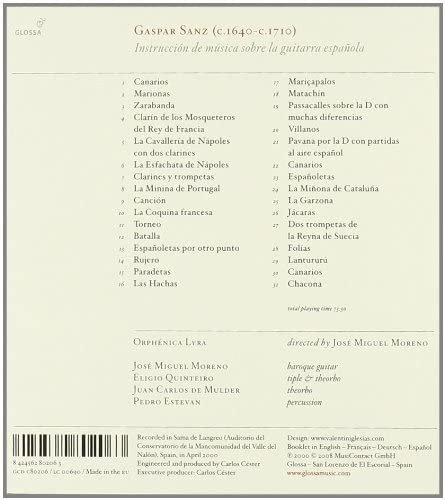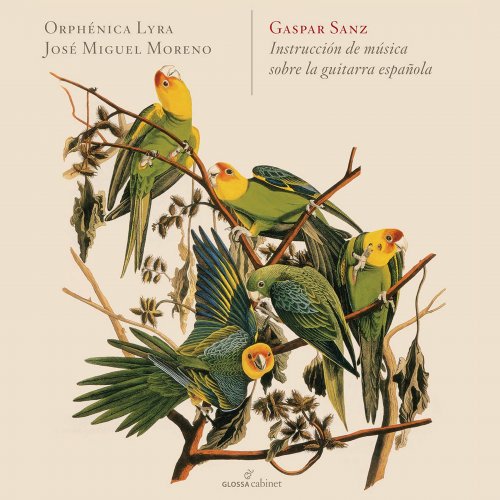
José Miguel Moreno - Sanz: Instruccíon de Música (2020)
BAND/ARTIST: José Miguel Moreno, Orphénica Lyra
- Title: Sanz: Instruccíon de Música
- Year Of Release: 2020
- Label: Glossa
- Genre: Classical
- Quality: FLAC (tracks)
- Total Time: 73:10 min
- Total Size: 333 MB
- WebSite: Album Preview

Tracklist:
1. Canarios (1)
2. No. 17, Marionas
3. No. 8, Zarabanda
4. No. 37, Clarín de los Mosqueteros del Rey de Francia
5. No. 28, La Cavallería de Nápoles con Dos Clarines
6. No. 33, La Esfachata de Napoles
7. No. 27, Clarines y Trompetas
8. No. 35, La Minina de Portugal
9. No. 29, Canciones
10. No. 31, La Coquina Francesa
11. No. 31, Torneo
12. No. 32, Batalla
13. No. 12, Son Españoletas por Otro Punto las Que Se Siguen
14. No. 5, Rujero
15. No. 6, Paradetas
16. No. 2, Las Hachas
17. No. 18, Mariçapalos
18. No. 7, Matachín
19. No. 33, Passacalles Sobre la D con Muchas Diferencias
20. No. 16, Villanos
21. No. 22, Pavana por la D
22. Canarios (2)
23. No. 11, Espanoletas
24. No. 34, La Miñona de Cataluña
25. No. 30, La Garzona
26. Jácaras
27. No. 36, Dos Trompetas de la Reyna de Suecia
28. No. 4, Folías
29. No. 32, Lantururú
30. Canarios (3)
31. No. 10, Chacona
As the lusty semi-popular vocal styles of the Spanish Baroque have gained prominence, the instrumental music of the era that in many cases forms its natural counterpart is being recorded. The Instrucción de Música sobre la guitarra española of Gaspar Sanz (1674), which is somewhere between a true instruction manual and a collection of music, which would have been known only to specialists even in the last decades of the 20th century, has received several recordings. This one, recorded in the year 2000 by Spaniard José Miguel Moreno, lies somewhere near the interpretive mean, and it makes both a safe and an enjoyable choice. The pieces, all quite short, include dances, imitative and programmatic works (the Batalla or battle piece, track 12, has counterparts in many other European traditions of the time), pieces based on vocal models, and ground-bass pieces like the Chacona that concludes the set. Some of the genres, like the vigorous Canarios and the Mariçapalos (or Marizápalos) will be familiar to fans of Jordi Savall's successful recordings of the Spanish repertory. Also familiar to Savall's listeners, but much less so to lovers of other European guitar traditions, will be the presence of an accompanmental group, with theorbo and/or tiple and percussion. This music has sometimes been performed without the accompaniment, but it's pretty clear from Sanz's own writings that he had one in mind. It's also possible to add a larger percussion contingent; the percussion here, from the ubiquitous Pedro Estevan, is light but lively. The understanding of how this music should be performed is still evolving, but Moreno's readings feel natural and integrated, and he's quite an expressive player whose way of taking a little time in the opening bars of a piece brings home the fact that Sanz in his own time would have been a renowned and charismatic performer. Glossa's sound, recorded in a music conservatory auditorium, is ideal, with guitar sounds coming through only in intense, silent passages. The booklet notes, in English, French, German, and Spanish, go into quite a bit of detail about the performance issues surrounding this music, but this release can be recommended even to those with a more general interest.
Year 2020 | Classical | FLAC / APE
As a ISRA.CLOUD's PREMIUM member you will have the following benefits:
- Unlimited high speed downloads
- Download directly without waiting time
- Unlimited parallel downloads
- Support for download accelerators
- No advertising
- Resume broken downloads


